Green Ash Tree: Leaves, Bark (Pictures) – Identification and Care Guide
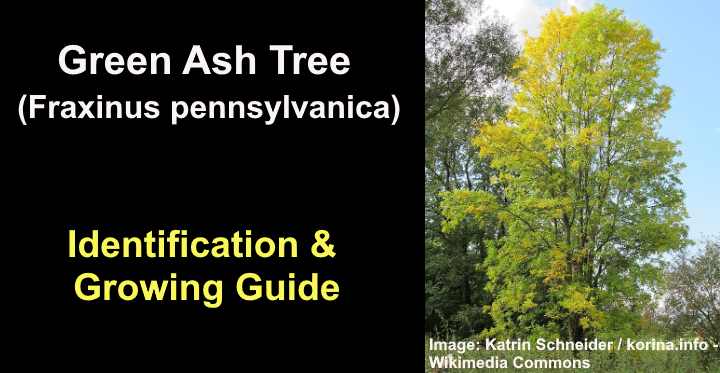
The green ash tree (Fraxinus pennsylvanica) is a medium-sized, fast-growing deciduous tree with large, glossy, dark green leaves and an irregular pyramidal crown. A green ash tree has gray-brown furrowed bark with diamond patterns, small clusters of spring flowers (panicles), and long winged fruit called samaras, similar to the seeds of maples.
Green ash is a native North American deciduous tree and one of the most common ash trees. The landscape tree grows quickly in most well-drained soils and can withstand periods of drought and flooding. Additionally, this popular ornamental tree also has excellent pest and disease resistance.
This article is a guide to identifying the green ash tree. Descriptions and pictures of green ash leaves, flowers, bark, and seeds will help you recognize this tree in a landscape. In addition, you will get helpful information on planting and growing this attractive tree.
Green Ash Tree (Fraxinus pennsylvanica) Facts
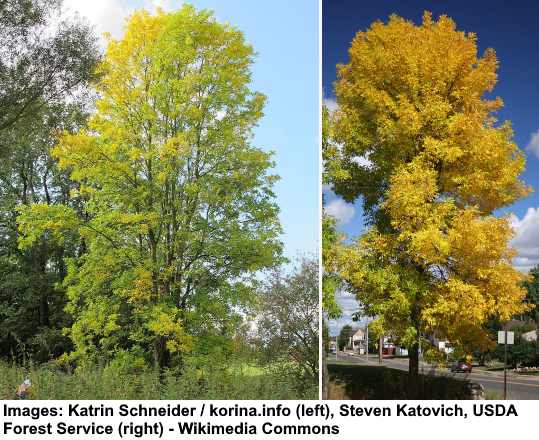
Green ash trees (Fraxinus pennsylvanica)
Green ash is an ash tree species native to North America in the genus Fraxinus and family Oleaceae. The medium-sized landscape tree grows 40 to 80 ft. (12 – 25 m) tall and up to 50 ft. (15 m) wide. The straight silvery-brown trunk can measure 24” (60 cm) in diameter.
The green ash is a deciduous flowering tree that produces small clusters of green and purplish flowers. The ash tree is classed as dioecious, meaning that male and female flowers grow on separate trees.
Green ash trees thrive in USDA zones 3 through 9. They are the most commonly planted species of ash trees because they tolerate a wide range of growing conditions. Green ash trees grow well in clay, waterlogged soils, or sandy, drought-prone soils in full sun.
Green ash is native to much of central and eastern North America. Its range extends from the Midwest and the Great Plains to the east coast of the US. The green ash also grows in North Florida in the panhandle along the Gulf coast to east Texas.
Green ash trees are also called red ash. However, it’s generally the younger trees that are called red ash due to their reddish-brown twigs and bark. Mature Fraxinus pennsylvanica species are typically called green ash.
Green ash trees are fast-growing ornamental trees. The ash tree’s rapid growth means it increases in height more than 24” (60 cm) per year, maturing on average at 70 ft. (21 m) tall.
Green Ash Tree Leaves

Green ash leaves
Leaves on green ash trees are pinnately compound, consisting of five to nine large leaflets. The blades are lanceolate or ovate and have finely serrated margins and a narrow apex. Green ash tree leaves grow 3” to 4” (7.5 – 10 cm) long, growing oppositely on twigs.
Green ash tree leaves are dark glossy green from spring until early fall. Then the leaves turn a showy golden yellow color in fall before dropping to the ground.
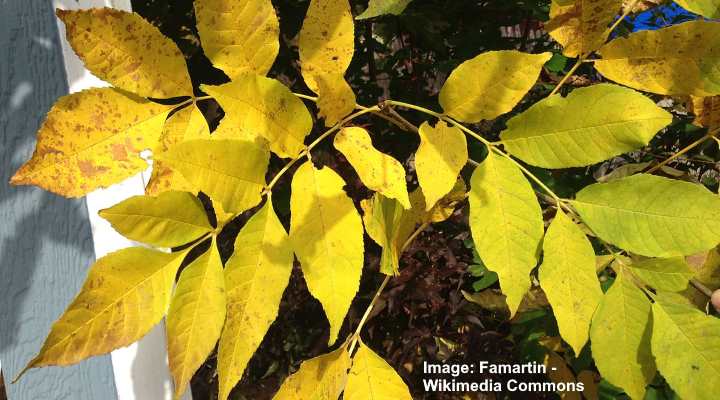
Green ash leaves in autumn
Green Ash Tree Bark
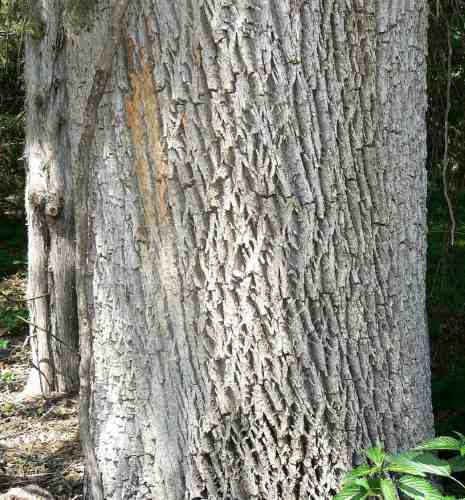
Green ash bark
Bark on green ash tree trunk is gray-brown or ash-gray and has narrow crisscrossing ridges that form diamond-shaped patterns. The attractive bark has a rough texture and silvery-brown appearance. The intricate patterning and appealing color give the tree plenty of visual appeal in the winter.
Green ash tree branches tend to have a fuzzy appearance when young. As the tree ages, the branches become smooth.
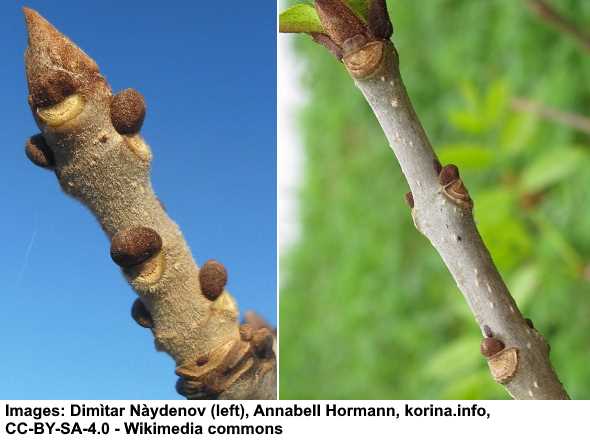
Green ash twigs
Green ash trees are easy to distinguish from other ash species due to their D-shaped or semi-circular leaf scars. The white ash tree (Fraxinus americana) has leaf scars on twigs in the shape of the letter C.
Green Ash Tree Flowers

Green ash flowers
Flowers on green ash trees are light green to purplish flowers that grow in loose panicles and bloom in early spring. The small clusters of petal-less, tubular flowers are usually less than 1” (2.5 cm). Male and female flowers bloom on separate trees.
Green Ash Tree Seeds
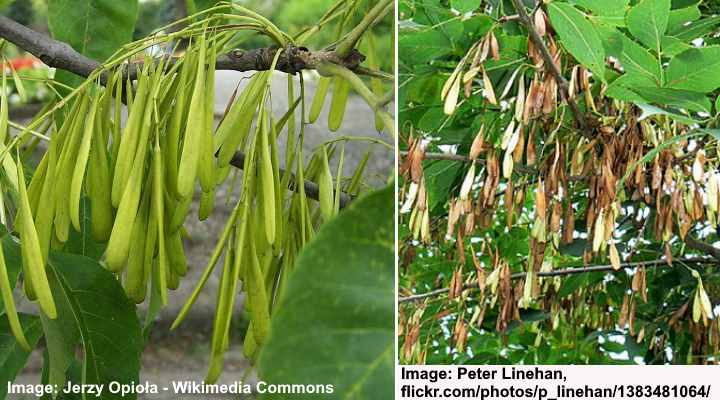
Green ash fruit is called samara and comprises a single seed. In the picture: immature green fruit (left) and mature brown seeds (right)
Seeds on green ash trees are paddle-shaped seeds in papery casings. The winged seeds grow in drooping clusters after female trees finish blooming. The long pendulous samaras (seed capsules) grow up to 3” (7.5 cm) long. The ash tree fruit ripens in the fall but may persist on the ash tree through winter.
The long drooping samaras help to identify female ash trees from male species as only pollinated female green ash trees produce fruit. However, this makes female ash trees somewhat messy. Therefore, to avoid clearing fallen fruit, plant a male green ash tree or a seedless cultivar.
Green Ash Tree Identification
The green ash tree is identified by its grayish-brown bark with a distinct diamond patterning. The medium-sized tree’s characteristics are pinnately compound leaves measuring up to 12” (30 cm) long and consisting of five to nine large dark green ovate or lanceolate leaflets, small green-purplish flowers, and clusters of drooping winged samaras.
Where to Plant Green Ash Tree
Plant a green ash tree in the sunniest part of your yard in any type of fertile, moist, well-drained soil. Due to the ash tree’s size and spread, don’t plant it next to buildings or other structures that could impede it. Therefore, plant the green ash about 30 ft. (10 m) away from buildings or other trees.
How to Plant Green Ash Tree
Plant a bare root green ash tree in fall while it is dormant. Dig a hole twice as wide as the root ball and the same depth. The top of the roots should be no deeper than 1” (2.5 cm) below the soil surface. Then set the root ball in the hole and backfill with native soil.
To eliminate air pockets from the planting site, press the soil down around the trunk as you fill in the hole. Then once the green ash tree has been planted, thoroughly water the site with plenty of water. Lastly, spread a layer of mulch that is 3” (7.5 cm) thick around the root area to conserve moisture and suppress weeds.
How to Grow Green Ash Tree From Seed
Growing a green ash tree from seed is relatively easy. Green ash is a fast-growing native shade tree; however, the seeds take some time to germinate.
Collect the ash tree seeds in late summer or early fall, remove them from their winged casings, and put them in a bucket of water. Discard any that float.
To speed up germination, it’s crucial to stratify the green ash seeds. Half-fill a sealable plastic bag with moist peat moss and put in a handful of seeds, and seal the bag. Then, place the bag of seeds in a warm place for four weeks. After that, put it in the refrigerator for eight weeks.
For the next step to grow a green ash tree from seed, place individual seeds in small pots filled with damp peat moss. Cover with plastic and put in a warm, bright place but out of direct sunlight. It’s good to remember that green ash seeds can take up to 18 months to germinate.
Once green ash seedlings start to sprout, you can transfer them to a larger container and continue growing until they reach about 6” (15 cm) tall. After that, you can plant the rooted ash tree in a sunny spot in your garden.
Green Ash Tree in the Landscape
A green ash tree is a beautiful, fast-growing shade tree for landscapes. The erect ash tree with its oval to pyramidal habit and attractive bark creates visual appeal, even in winter. In addition, the ash tree’s wide canopy and dense foliage make it ideal as a street or shade tree.
Seedless varieties of green ash are especially useful in urban landscapes because they don’t make much of a mess. Additionally, the green ash tree’s adaptability to urban conditions and soil compaction mean it will grow almost anywhere.
Green Ash Tree Care Guide
Green ash trees are very popular because they are easy to care for and thrive under challenging conditions, including poor soil and drought. However, there are a few things to know about caring for a green ash tree so that it thrives and is resistant to pests and disease.
How to Water Green Ash Tree
Water a green ash tree regularly throughout the growing season and reduce watering significantly in winter. During summer, water the ash tree every ten to 14 days up to a depth of 24” (60 cm) to hydrate the root system. In spring and fall, water every three to four weeks.
During winter, green ash needs watering only when there’s no snow cover. Even then, reduce the watering frequency to every six weeks if there’s been no rainfall.
Adequate watering is vital for a green ash tree’s health. Although established ash trees are relatively drought-tolerant, they are susceptible to pests during extreme drought. The most common pest is the emerald ash borer, which is the greatest threat to the tree’s health.
Green Ash Tree Fertilization
Green ash trees thrive in fertile, moist soil and benefit from an annual application of compost or manure. In June, you can fertilize young green ash trees to encourage rapid growth and excellent health. Mature green ash trees typically don’t require additional fertilizing unless the tree is stressed.
If you decide to fertilize a green ash tree, apply a slow-release fertilizer in early spring. You can use a balanced tree fertilizer such as one with an NPK rating of 3-1-1 or 3-1-2. Signs that a green ash tree requires fertilization include slow growth, yellowing leaves, or dead branch tips.
How to Prune Green Ash Tree
The best time to prune a green ash tree is while it’s young and during winter dormancy. First, you should remove the thinner of two adjoining branches and trim branches to create a central leader. This also helps to thin stems and improve airflow through the foliage.
However, even if you don’t have time to prune a young green ash tree, it will still grow into an elegant ornamental shade tree.
In late winter or early spring, prune mature green ash trees to remove dead, decaying, or diseased branches. Also, look for branches rubbing together or growing back toward the tree. Removing these branches encourages good health and prevents pests or disease from affecting your tree.
Green ash trees tend to sprout suckers from around the main trunk. So, regular tree maintenance requires removing these from June through August to keep your tree growing healthy.
Green Ash Tree Propagation
Propagating a green ash tree from cuttings is the fastest way to grow a new tree. In summer, you should take a few 8” (20 cm) twig cuttings of new, green wood. Strip some of the bark from the cut end and remove all leaves except the few at the tip.
To root a green ash cutting, dip the cut end in some rooting hormone. Then place the twig a few inches deep in a pot containing moist peat moss and put it in a warm, bright location. Ideally, there should be at least three nodes in the soil. Mist the soil daily to keep it moist.
It takes around eight weeks for the green ash cutting to root. However, the cutting should remain growing in the container until new growth appears. This may take several months. Usually, you can transfer a green ash tree to the ground the following season.
Pests Affecting Green Ash Tree
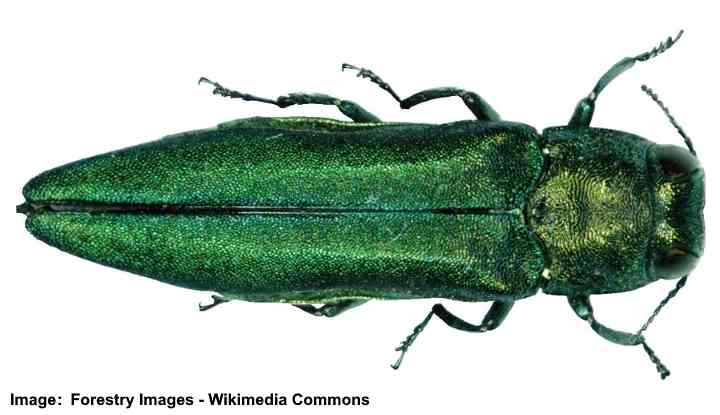
Emerald ash borer
The most common pest affecting a green ash tree is the emerald ash borer. Other destructive insects affecting a green ash tree include sawflies, spider mites, leafcutter bees, and scale insects.
Emerald ash borer (Agrilus planipennis) is a non-native invasive beetle that can kill an ash tree in three to five years. The insect larvae live in the bark, feeding on the tree’s nutrients and starving it of moisture. It is reckoned that the larvae of this green beetle kill millions of ash trees annually. The lilac borer (Podosesia syringae) can also do damage to a green ash tree.
Signs of emerald ash borer activity include the following:
- Vertical fissures on bark
- Winding feeding trails on the exposed inner bark
- Increased woodpecker activity
- D-shaped holes where adult beetles have emerged
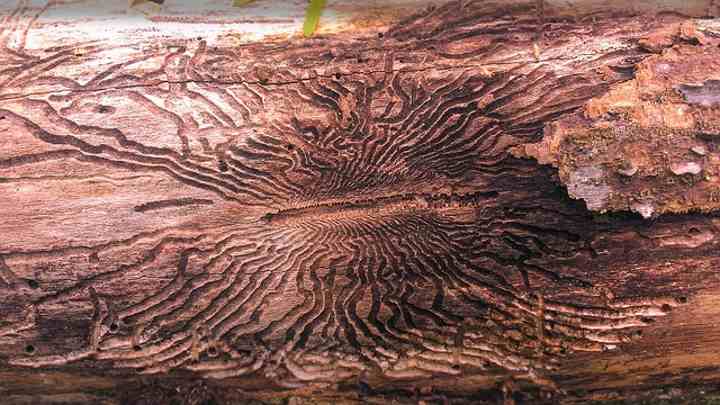
Emerald ash borer damage
If you suspect emerald ash borer activity, it’s best to call professional arborists for advice.
Brown-headed ash sawfly (Tomostethus multicinctus) is a pest of green ash, as well as other types of ash trees. The tree-damaging insects are the larvae that feed on ash leaves, skeletonizing them until virtually none are left. However, new leaves will still emerge in spring, even after complete tree defoliation.
Leafcutting bees (Megachilidae) are beneficial pollinators. However, their tiny larvae munch on green ash leaves, creating round holes on the edge of ash leaves. The holes are perfectly circular, looking like a paper punch has made the hole.
Diseases Affecting Green Ash Tree
Fungal and bacterial diseases can affect green ash trees if the trees are stressed. Typically, ash trees growing in full sun and getting adequate hydration are resistant to disease. However, ash rust, anthracnose, and verticillium wilt can affect an ash tree’s growth.
Ash rust is a fungal disease caused by the fungus Puccinia fraxinata. When a tree is infected, leaves, stems, and small twigs may swell and become distorted. Additionally, canker-like growths may form on the branches, which can cause leaves to appear brown in summer. You may also notice bright yellow or orange powdery spores on the tree.
Verticillium wilt affects many shade trees, including green ash trees. This soil fungus affects leaf growth by attacking the vascular system of deciduous trees. Signs of wilt include tree leaves exhibiting signs of yellowing and wilting. Sometimes the entire crown can appear dried and withered.
Watering the green ash tree regularly should help reduce stress and improve its health. However, it’s also vital to prune and destroy affected branches and foliage.
Anthracnose is a foliar disease that causes green ash leaves to develop dark brown or black irregular spots on leaves. The unsightly brown patches may spread out from the leaf’s central vein. However, this fungal disease is rarely lethal to ash trees.
Related articles:
